Recycling and composting programs are an effective way for municipalities to achieve GHG emissions reductions by diverting waste from landfills. The key to success, however, lies in developing a coordinated system of participants and facilities supported by a foundation of policy, partnerships, programs, and performance management.
Municipalities exploring opportunities to expand their sustainability initiatives have a myriad of motivations. Municipal Sustainability or Climate Action Plans (CAP) often include goals to reduce greenhouse gas (GHG) emissions, expand renewable energy, and increase environmental stewardship. Given the prominent role municipalities play in the provision of utility services, they are in a unique position to champion initiatives to divert waste from landfills.
Food waste that accumulates in landfills decomposes in the absence of oxygen, creating biogas, which contains methane (CH4), carbon dioxide (CO2), hydrogen sulfide (H2S), water vapor, and other trace gases. Methane has 28 times greater global warming potential (GWP) than carbon dioxide, making it a potent greenhouse gas. Discarded products in landfills often contain chemicals, materials, and gases that leach into groundwater or release harmful substances into the air, negatively impacting the environment and human health. Recycling and composting programs mitigate these effects by diverting food and yard waste and recyclable material away from landfills, a growing national trend since 1990 (Figure 1).
Figure 1: Municipal Solid Waste Management, 1960-2018
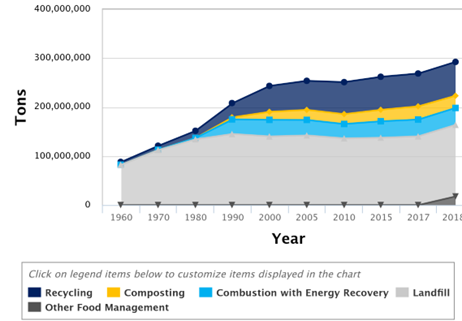
Business and Residential Waste Generation
Businesses and residents generate a range of waste, including items at the end of their useful life, packaging, building materials, food scraps, yard debris, hazardous materials, and general trash. These items can be diverted from landfills and processed through material recovery facilities (MRFs), composting services, and hazardous material facilities (Figure 2).
The collection, processing, and reuse of recyclable materials, food and yard waste, and hazardous materials requires a coordinated system between residents, businesses, haulers/collectors, facilities, nonprofits, and government agencies. This system is supported by policies, partnerships, programs, and performance management. To illustrate the elements necessary to create a successful system, this article highlights the City of Boulder’s Zero Waste program as a case example.
Figure 2: Waste Generated by Residents and Businesses
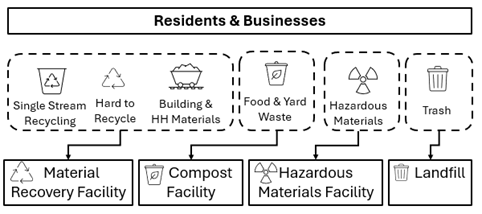
The Recycling and Composting System
A successful zero-waste program relies on several participants (Figure 3). Haulers provide curbside services to collect single-stream recycling, food and yard waste, and trash from residents and businesses. Single-stream recycling is sorted at MRFs, processed, packaged, and shipped to specialized recycling centers. Dropoff facilities serve residents and businesses by accepting larger or hard-to-recycle items, including hazardous materials such as chemicals, paint, and solvents. Food and yard waste is collected, consolidated, and transported to composting facilities, where it is processed and then sold to farmers, nurseries, municipalities and other customers. Trash is consolidated at processing stations and eventually sent to landfills.
Figure 3: Recycling, Food & Yard Waste, Hazardous Materials, and Trash Collection System

Participants in Boulder’s Zero-Waste Program
In Boulder, haulers such as Western Disposal Services and Republic Services provide curbside services, while nonprofits primarily manage specialized facilities. Nonprofit Eco-Cycle is contracted by Boulder County to operate the Boulder County Recycling Center (BCRC) and also operates the Center for Hard-to-Recycle-Materials (CHaRM) facility which is subsidized by the City of Boulder. Boulder County operates the Hazardous Materials Management Facility (HMMF), and building materials are collected, processed, and resold by Resource Central. CHaRM and the BCRC sell materials to markets specializing in the recycling of cardboard, paper, glass, plastic, aluminum, and steel. Food and yard waste collected by Western Disposal is transported to A1 Organics, which processes the material into compost. Trash collected by various haulers is consolidated at a collection center before transported to a landfill.
Figure 4: City of Boulder Collection System
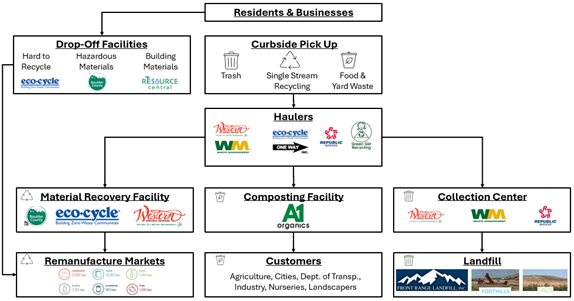
Supporting Policy
A mix of funding mechanisms and regulations underpins Boulder’s zero-waste initiative (Figure 5). For example:
- 1991: Funds collected over 20 years from city and county budgets supported the construction of the HMMF.
- 1994: Boulder citizens approached an occupational tax on haulers operating in Boulder, otherwise known as the “trash tax” to fund curbside recycling services. That same year, a countywide recycling sales and use tax of one-tenth of a cent was approved (over a 7-year period) to fund construction of the BCRC.
- 2001: An ordinance was passed requiring all trash haulers to provide curbside recycling services and adopt a Pay-As-You-Throw (PAYT) pricing structure to incentivize waste reduction.
- 2015: The City of Boulder’s zero-waste ordinance mandated separate collection services for recycling, food & yard waste, and trash for all residential and commercial properties.
Figure 5: Supporting Policy
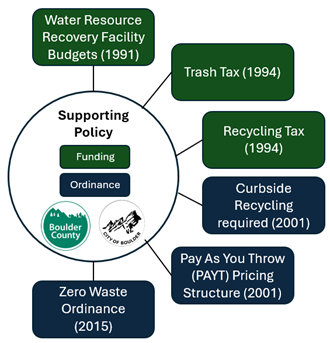
Construction and Operations
Due to small profit margins, material recovery facilities are often only operated by government entities or nonprofits (Figure 6). Agreements on facility ownership and operations allow government entities to maintain control while leveraging nonprofit operational expertise. For example, Boulder County owns the BCRC but contracts Eco-Cycle to operate it. Nonprofits like Eco-Cycle and Resource Central operate facilities on city-owned land. Operations are funded through a mix of tax revenues, user fees, and material sales. Operating costs for the HMMF are allocated to participating cities and counties based on resident usage.
Figure 6: Ownership, Operations, and Funding for Material Recovery Facilities and Haulers
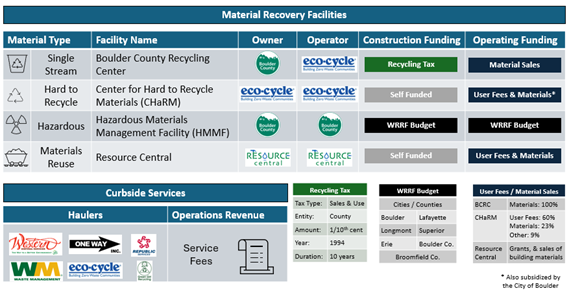
Zero-Waste Program Timeline
Boulder’s journey to establishing a zero-waste program reveals a sequence of milestones (Figure 7). Key steps include:
- Community activism to champion recycling and composting
- Partnerships between the community, government entities, nonprofits, and the private sector
- Pilot project testing to determine feasibility and community acceptance
- Funding sources to scale pilot projects citywide
- Facility development (construction and operations)
- Connections with markets for recycled and composted materials
- Performance monitoring to meet established objectives or minimum requirements
Figure 7: Sequence of Milestones to Achieve a Zero-Waste Program

Eco-Cycle: The Heart of Zero Waste in Boulder
Founded in 1976, Eco-Cycle has been pivotal in advancing Boulder’s zero-waste initiatives (Figure 8). The nonprofit operates the CHaRM and BCRC facilities, provides educational programs, and partners with local governments and organizations. Its activities include community outreach, advocacy, and operational services like hauling and waste audits. Eco-Cycle also collaborates with the Colorado Public Interest Research Group (CoPIRG) to publish the annual “State of Recycling and Composting in Colorado” report.
Figure 8: Eco-Cycle Activities
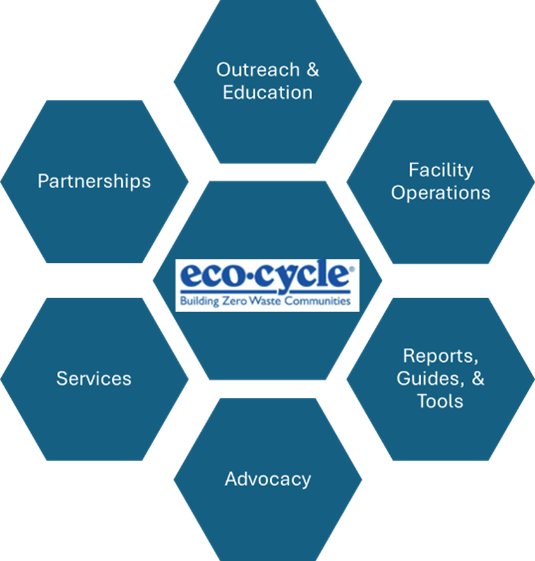
Performance Management
Commonly used metrics for evaluating zero-waste programs include:
- Volume/Tonnage: Total materials processed (landfill, recycled, or food/yard waste material)
- Waste Diversion Rate: Percentage diverted from landfills to recycling and composting facilities
- Discard Rate: Percentage of contaminated recyclable or compostable material sent to landfills
- GHG Emissions Reduction: Measured in tons of reduced CO2, CH4, and N20
- Financial Impacts: Savings from reduced landfill fees and material sales
The City of Boulder established a data dashboard (Figure 9) to track several of these metrics, aiming for a waste diversion rate of 85% by 2025. As of 2024, the city diverts 56% of municipal waste.
Figure 9: City of Boulder Zero-Waste Diversion Data Dashboard
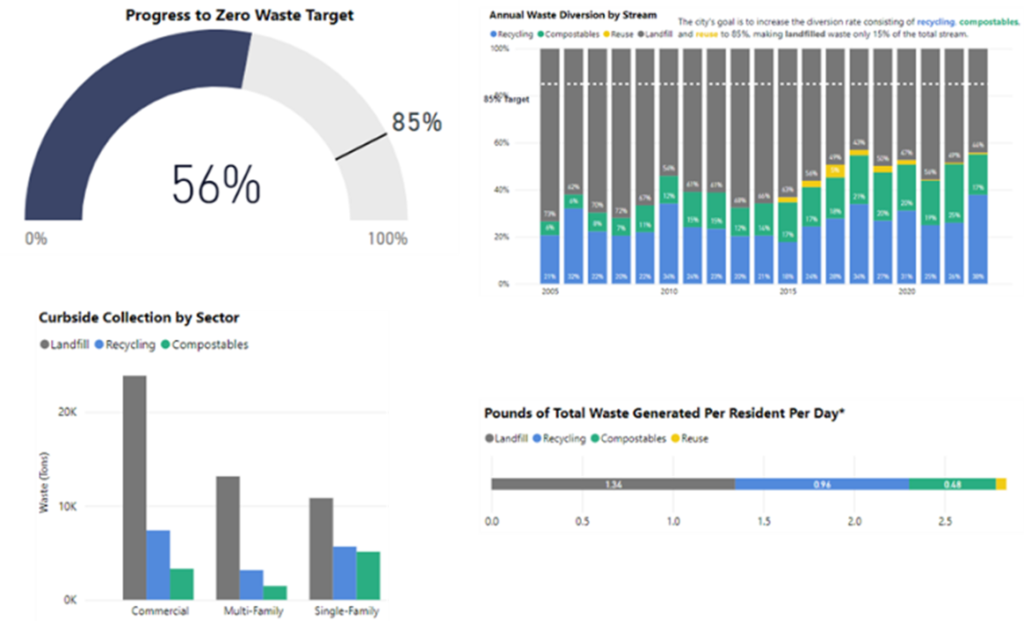
Conclusion
A successful zero-waste program requires collaboration among community members, government entities, haulers, nonprofits, and facility operators. Program success also depends on sequential milestones such as community advocacy, partnerships, funding, and other initiatives to build a robust and sustainable system. With these elements in place, municipalities can achieve significant environmental benefits in line with climate action goals. For more information about how your organization can most effectively design and implement zero-waste programs, please contact Canopy Edge for a consultation.


